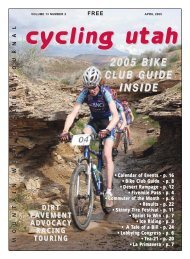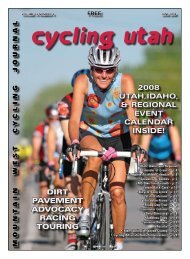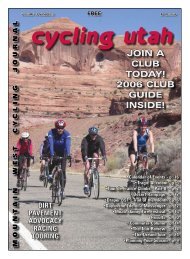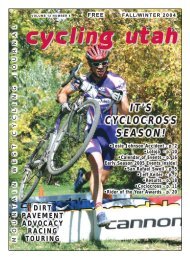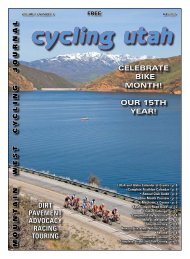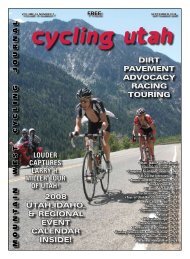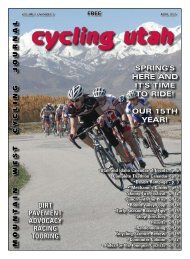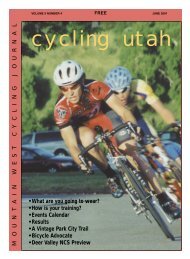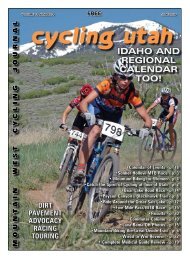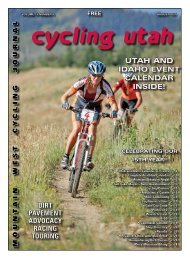April 2008 Issue - Cycling Utah
April 2008 Issue - Cycling Utah
April 2008 Issue - Cycling Utah
- No tags were found...
Create successful ePaper yourself
Turn your PDF publications into a flip-book with our unique Google optimized e-Paper software.
APRIL <strong>2008</strong> cycling utah.com 27Ashley Patterson on top of the world above Bountiful.area for possible better places to staywould have been a good idea.However, the distance fromLayton to Kaysville did give us anice warmup the next morning forthe initial climb of what we knewwould be a long day. FarmingtonCanyon to Bountiful Peak is just acouple hundred feet shy of a continuous5000 foot climb, and that’sto the beginning of the difficultsection. We knew that it takes someof the fastest Wasatch 100 runnersaround 5 hours to go from the topof Farmington Canyon to the Brink,and based on Bromka’s descriptionof this section of the Great Westernas being for the masochists who lovetaking their bikes for long walks,we knew that we would probablybe slower than unencumbered runners.Sure enough, this section ofthe Great Western traversing thelittle-traveled Sessions Mountainslived up to its reputation as a grueling,time-consuming and drainingendeavor. There were some funrideable sections for sure in this surprisinglyremote section (surprisingsince we were actually only a fewmiles from downtown Bountiful andSLC at the head of the canyons ofMueller Park and City Creek) butmuch of it was slow and hot hiking,even after we reached the infamousBrink section.When we finally reached BigMountain, we were ready for thewell known and super fun descentdown the Mormon Trail and thesubsequent spin up East Canyon toJeremy Ranch. Again, this sectionis a possible compromise of a true“traverse” given the opportunity toride the fun – but challenging andtime consuming – continuation ofthe Great Western Trail along theridge above Little Dell towardsParley’s Summit, but after 10 hoursin the saddle we had no problemwith our decision, and given thefatigue we felt in climbing past theJeremy ranch golf course and fromJeremy to Summit Park we werepretty much done for the day. Westumbled into our friends’ house justas their birthday party for their twoyear old was getting into swing, butwith a shower and copious birthdaybarbeques and cake we were rejuvenatedenough to last until we collapsedinto bed.The next day was a welcomechange (after our previous day’shikefest) to flying along familiarbuffed singletrack. Joined by twoof our gracious hosts, we groundup through the maze of Pinebrookand then tore across on the midmountaintrail to PCMR, where weclimbed easily up to Scott’s pass andraced down Guardsman to Brighton.A quick refuel at the store was necessarybefore making our way slowlyup the Millicent side to the TwinLakes dam, where we caught a hikingtrail up to the traverse to TwinLakes Pass. This involved a bit ofhike-a-biking, but relative to the previous-day’santics it seemed trivial.We bounced down Grizzly Gulch toAlta, and were again welcomed withopen arms into our friends’ home,and this time we not only had moretime to socialize but were a bit morecoherent after a far-easier day.Our last day started with a nicecruise up into Albion Basin and thena short stout climb to Catherine’sPass. A short sandy hike brought usto the glorious view of the entirecentral Wasatch and the Timpanogosmassif, and we began the relativelytreacherous descent into Dry Creek;the uppermost drainage of theAmerican/Tibble Fork Drainages.As we picked our way down thesteep, loose, and rocky descent Ionce again marveled at the Wasatch100 runners who – in a week’s time– would be negotiating this not onlyat mile 75 or so, but also most ofthem would be in the dark. Quiteimpressive. An inauspicious left turnback onto the Great Western broughtus to the last notable hike-a-bike ofour journey of about 15 minutes tothe top of Ant Knoll, where amazingcruising would lead us to PoleLine Pass and beyond on the 157trail (which has definitely been hammeredlately by motos).Once on the 157 it’s possibleto have multiple excellent finishesto a trans-Wasatch. Our originalintent had been to drop down toTimpanooke and do the awesomeTimp Traverse, finishing with a finalgut-busting climb up to Bald Knolland a finger/forearm-crimping 3500foot technical singletrack descentto the Provo river, but we ran outof time and instead dropped downthe equally hoot-raising Tibble Forksingletrack and then cruised downAmerican Fork Canyon where wemet the Canyon Shuttles driver(who brought us back up to SLC for$100).There are multiple ways to dothis ride, and any/all of them work,but having the support of strategically-placedgood friends helps a lot.It’s tempting to say it’s “destinedto be a classic”, but the difficultyand logistical challenges will probablykeep it off the IMBA-epic list,which is probably just as well. Inany case, it’s a grand and uniqueadventure that looms literally rightin our backyard.Book reviewTerrific Book Recounts Origins ofSix-Day Track RacingBy Greg OvertonPeter Joffrey Nye, along withJeff Groman and Mark Tyson, haspresented a wonderful book for thecoffee table or library of any cyclingenthusiast, and a must for any trackracing or cycling history fan. TheSix-Day Bicycle Races, America’sJazz Age Sport, is a hardcover bookcontaining 300 photographs andillustrations within its 224 pages,and intersperses the visual withwonderful text and captions thatgive the reader a sense of what thesport was like, especially in the early20th century, when six-day racerswere the highest paid and mostfamous athletes in sport in the USA.Nye recounts the sport’s travelingspectacle as it covered the U.S.,including Salt lake City’s Salt Palacetrack, where John Chapman andIver Lawson set the 5-mile tandemrecord in 1901, at more than 30mph.Chapman later returned to managethe Salt Palace track and went on tobecome one of the sports most influentialpromoters. Other names thatfactor prominently in the book canbe looked upon as the grandfathersof American racing, Fred Kramer,Jack Simes Sr. and Jr., Major Taylor,Bobby and Jimmy Walthour, racerswho were being paid up to $20,000per year at a time when baseballplayers were paid hundreds andoriginal NFL franchises were offeredfor $100. There were bad times, too,and the book covers the dark periodin the middle of the century, andthen the rebound, mostly in Europeas top road racers used the six-daysfor winter training. Some Americanracers also competed, culminatedby Olympic and World ChampionMarty Nothstein teaming with RyanSimes Oelkers winning the 2002six-day World Championship inMoscow.The 8 ½” x 11” format offerslarge photographs and illustrationsworthy of a coffee table flip-throughjust for the visual, but the text willundoubtedly draw your interest asit’s placed in and out of the illustrationsand photos of the riders,event posters, tickets and newspaperaccounts. The book is a winning fulfillmentof a daunting task of gatheringhistorical data and organizing itto give an interesting and fun retrospectiveof this once mighty sport.It’s a $39.99 investment that willhave you returning again and again,a wonderful accomplishment that isrecommended to more than just thehardcore cycling aficionado.Published by Cycle Publishing,2006.



